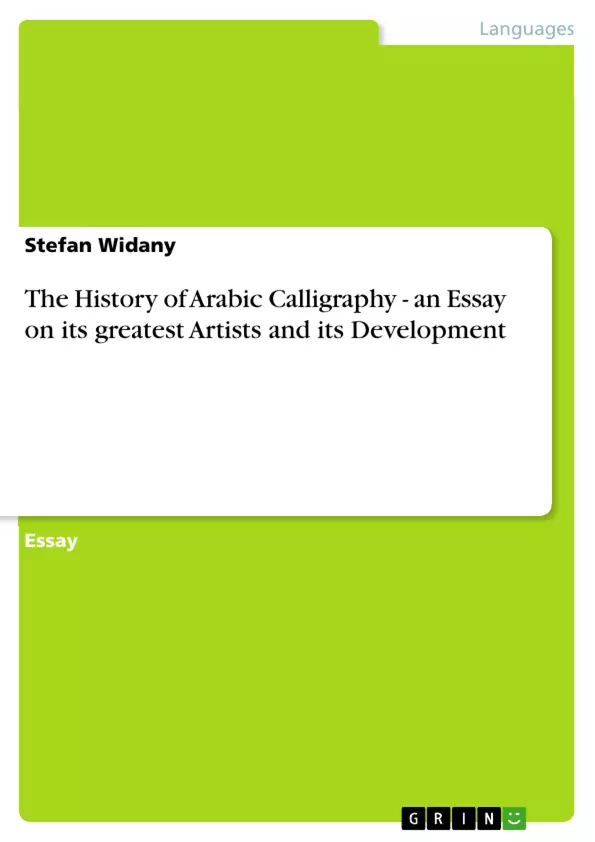In this Essay I will give a general overview of the development of Arabic Calligraphy from its beginning till today. The reader will soon learn that the evolution of this elaborate and complex art was always closely linked to great personalities. Artists that, in its early times, formed and systematized this art, later brought it to its peaks and in the last centuries revised and modernized it. Writing about the History of Calligraphy will therefor be writing about a line of persons that, step by step, on succeeded by another, defined Arabic calligraphy in their time and, in its whole, brought it to where it is today.
As Calligraphy is the art of elaborated writing it is of course closely linked to script and language. The Arabic language developed already before the coming of Islam1, but Arabic calligraphy as an art with different styles, uses and a certain place in society, was a phenomena that appeared in the time of the first great empires. That is why I will focus on the development in and after this times. That means I'm not gonna investigate preislamic Arabic calligraphy or look at the development of the Arabic language and its aesthetic aspects (fields that would provide enough material for interesting researches for its own).
As the art I will write about has been performed for many centuries and in a great extend, there are many old and new works in display around the work. In the appendix some of them will be shown, to give examples and make this essay a little more than just a historical investigation.
Table of Contents
- Introduction
- Beginnings
- Ibn-Muqla and his life's work
- Ibn al-Bawwāb
- Al-Ġuwaynī and Yāqūt al-Musta ṣimī
- Calligraphy during the Ottoman Age
- Modern Arabic calligraphy
Objectives and Key Themes
This essay offers a comprehensive overview of Arabic calligraphy, tracing its evolution from its origins to the present day. The work emphasizes the significant role of key figures in shaping and refining this complex art form.
- The development of Arabic calligraphy as an art form.
- The influence of key artists and calligraphers on its evolution.
- The historical and cultural contexts surrounding the development of Arabic calligraphy.
- The various styles and uses of Arabic calligraphy.
- The importance of calligraphy in different fields, including literature, lyric, architecture, and crafts.
Chapter Summaries
- Introduction: Introduces the essay's objective, focusing on the evolution of Arabic calligraphy, highlighting its connection to prominent individuals and its intricate nature.
- Beginnings: Discusses the emergence of early calligraphy, particularly the cufic style used in the first Qur'an manuscripts, and the development of state-sponsored calligraphy during the Umayyad dynasty. It mentions the rise of professional calligraphers and the flourishing of paper and ink production.
- Ibn-Muqla and his life's work: Presents Ibn-Muqla as a pivotal figure in Arabic calligraphy, recognizing him as a pioneer who established a significant foundation for the art form. It explores different accounts of his life and his contributions to calligraphic development.
Keywords
Arabic calligraphy, Islamic art, calligraphers, cufic style, Qur'an manuscripts, Umayyad dynasty, Abbasid dynasty, Ibn-Muqla, styles, techniques, development, history.
- Quote paper
- Stefan Widany (Author), 2010, The History of Arabic Calligraphy - an Essay on its greatest Artists and its Development, Munich, GRIN Verlag, https://www.grin.com/document/173622



